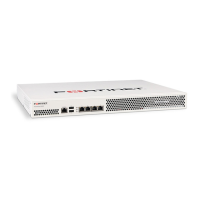Fortinet Technologies Inc. Page 15 FortiVoice 200D/200D-T v2.0 MR1 CLI Reference
For example, the edit sub-command is available only within a command that affects tables;
the next sub-command is available only from within the edit sub-command:
config system interface
edit port1
set status up
next
end
Available sub-commands vary by command.From a command prompt within config, two
types of sub-commands might become available:
• commands affecting fields
• commands affecting tables
Sub-command scope is indicated in this guide by indentation. See “Indentation” on page 12.
Syntax examples for each top-level command in this CLI Reference do not show all available
sub-commands. However, when nested scope is demonstrated, you should assume that
sub-commands applicable for that level of scope are available.
Table 2: Commands for tables
delete
<table_name>
Remove a table from the current object.
For example, in config system admin, you could delete an
administrator account named newadmin by typing delete newadmin
and pressing Enter. This deletes newadmin and all its fields, such as
newadmin’s name and email-address.
delete is only available within objects containing tables.
edit
<table_name>
Create or edit a table in the current object.
For example, in config system admin:
• edit the settings for the default admin administrator account by
typing edit admin.
• add a new administrator account with the name newadmin and edit
newadmin‘s settings by typing edit newadmin.
edit is an interactive sub-command: further sub-commands are
available from within edit.
edit changes the prompt to reflect the table you are currently editing.
edit is only available within objects containing tables.
end
Save the changes to the current object and exit the config command. This
returns you to the top-level command prompt.

